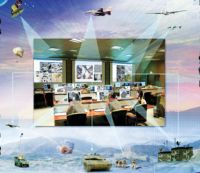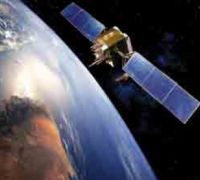Most measures aimed at information superiority and battlefield transparency are space based with a very heavy dependence on satellites. War fighting capability to win within an acceptable time frame would demand battlefield tempo and simultaneity in actions. The former can be achieved by effectively exploiting situational awareness to enable better and faster decision-action relative to that of our enemies. The aim here is to get inside the enemy’s decision-action cycle by exploiting information and acting upon it before the enemy has time to react. Simultaneity implies the ability to address the enemy all across the battle space, simultaneously.
The aim is to overload the enemy’s command set up, denying him the ability to concentrate on one problem at a time, or even establish priorities between problems. This would require improved collaborative planning between components and levels of command and better execution of coordinated action throughout the battle space. The enabling technology is digitisation of command systems, weapon platforms and structures. Military satellites are critical to the above operations.
This article is published with the kind permission of “Defence and Security Alert (DSA) Magazine” New Delhi-India
 |
| Click to enlarge |
Situational or battlespace awareness is a sine qua non of the modern battlefield which is characterised by hitherto unimaginable levels of transparency. This has to be a major thrust area and must include both the satellites and the terrestrial infrastructure of launch sites, tracking, telemetry and control (TT&C) facilities and the data links that bind the system together. India has a very high degree of core competency in the space sector. The ISR architecture will entail the use of Airborne Warning and Control System (AWACS), Geo-synchronous Earth Orbit (GEO) satellites, Low Earth Orbit (LEO) satellites, Unmanned Aerial Vehicles (UAVs), Unmanned Combat Air Vehicles (UCAVs) and Micro Air Vehicles (MAVs).
Military capability to protect the nation’s core values and interests is essential to prevent subjugation and preserve own freedom of action. Defence thinkers continue to search for the one singular elixir that will deliver operational success. While technology has thrown up many tantalising possibilities and has offered us the potential to change the way we choose to fight, the silver bullet which can deliver all-encompassing success is as elusive now as it was in the years gone by.
Neither today’s conflicts nor the wars of tomorrow will have a clearly definable, two-dimensional battlefield. This has given way to battle space. In the Indian context, it encompasses our landmass and island territories, the high seas, ocean depths, airspace, space, cyberspace and the electro-magnetic spectrum. It also includes the minds of our leadership and the population of the country. The spectrum of conflict cannot be perceived in terms of a neat easily comprehended linear escalator – with peace at one end and war at the other. It will remain a continuum within which lie a range of military and non-military conflict prevention, conflict and post conflict activities. The distinction between these is blurred.
While there may be no proverbial silver bullet to win future conflict, the side that has better situational awareness is more favourably placed to achieve victory. The knowledge of the strength, dispositions, capabilities and likely intentions of friendly and hostile forces will remain a key battle winning factor. This by itself is not a new thought or opinion. As Sun Tzu observed in another age and era:
‘It is only the enlightened ruler and the wise general who will use the highest intelligence of the army for purposes of spying and thereby they achieve great results. Spies are a most important element in war, because upon them depends an army’s ability to move’1.
In Sun Tzu’s time, two and a half thousand years ago, dependence was solely on human intelligence. Today, technology has given us the power to look all across the battle space – a function not possible in Sun Tzu’s era. The ability to look deep into the enemy’s rear is dependant to a large extent on space domination – and the side which dominates space will have the edge in future conflict.
Indian imperatives
India’s dispute with Pakistan over Kashmir has already led to four major conflicts, the last being Kargil where Pakistan once again suffered a humiliating defeat. But this has not lessened the prospects for future conflict. On India’s border with Tibet, differences with China over territorial claims could once again lead to conflict. With two of our major neighbours then, the casus belli for future conflict exists. This necessitates that our field force must have the capability to take to field at short notice and have the capacity and capability to defend our national interests. In turn, this would imply:
- Maintaining a high state of operational readiness at all times.
- Timely warnings of enemy build-up in our areas of concern.
- The ability to engage hostile forces all across the combat zone.
Domination of space would be essential to achieve the above. This implies the ability to control the use of space, at times and places of one’s own choosing, while denying an opponent the same ability.
 |
ISR in the modern battlefield cannot be devoted to ‘one run over the target area’ surveillance. It has to be continuous and on line. Thus, the ISR architecture will entail the use of Airborne Warning and Control System (AWACS), Geo-synchronous Earth Orbit (GEO) satellites, Low Earth Orbit (LEO), Unmanned Aerial Vehicles (UAVs), Unmanned Combat Air Vehicles (UCAVs) and Micro Air Vehicles (MAVs). Middle Earth Orbit (MEO) satellites have a large ‘dead time’ (the time over the ocean) and hence are not suitable for supporting land operations
This then has to be a major thrust area and must include both the satellites and the terrestrial infrastructure of launch sites, tracking, telemetry, and control (TT and C) facilities and the data links that bind the system together. Own systems need to be protected while capability to destroy enemy systems must be developed. India has a very high degree of core competency in the space sector. This needs to be dovetailed into a defensive framework.
For effective and timely force generation and battlefield domination, the force must have real-time ISR (Intelligence, Surveillance and Reconnaissance) capability. In the operational / tactical sense, ISR, via aerial / ground platforms and sensors, means the integration of ISR systems to permit commanders to comprehend the battlefield in real-time. This would permit reduced force generation time tactically as also maintain the battlefield tempo. Technology of course cannot be a stand-alone system and would have to be supplemented by Human Intelligence (HUMINT). But an aggressive peacetime ISR would enable both monitoring of the war preparedness of the adversary and his intent. ISR in the modern battlefield cannot be devoted to ‘one run over the target area’ surveillance. It has to be continuous and on line. Thus, the ISR architecture will entail the use of Airborne Warning and Control System (AWACS), Geo-synchronous Earth Orbit (GEO) satellites, Low Earth Orbit (LEO) satellites, Unmanned Aerial Vehicles (UAVs), Unmanned Combat Air Vehicle (UCAVs) and Micro Air Vehicles (MAVs). Middle Earth Orbit (MEO) satellites have a large ‘dead time’ (the time over the ocean) and hence are not suitable for supporting land operations. GEO satellites, with large coverage, would support ISR requirements of a strategic nature, while LEO satellites would play an effective role in the command and control of interactive systems in the battlefield since it has a low ‘latency’ signature (time delay for a signal from earth to the satellite and back). However, owing to their low orbit, a large number of such satellites would be required. This would derive positive advantage, as it would also cater to offset disruption in the event of a nuclear blast in space aimed at disabling the satellite communication and allied systems.
The use of UAVs and UCAVs are going to be major battle winning factors in the years ahead. Their utility has been validated in some of the recent conflicts across the globe, such as the Gulf war where over 330 missions of the Israeli Pioneer UAVs were flown. The conflict in Bosnia too, has validated the concept and employment of UAVs. Over the last few years, the RQ‑1 Predator drone has become the primary UCAV for offensive operations by the United States Air Force and Central Intelligence Agency in Afghanistan and the Federally Administered Tribal Areas (FATA) of Pakistan. Its utility reinforces the belief that UCAVs would soon become a ubiquitous part of the future battlefield. Over the Tibetan plateau, the nature and vastness of terrain again places a very heavy premium on air assets. Control over the air would be an essential prerequisite for successful conduct of ground operations. Air capability to hit at targets at depth would necessitate having a strong and capable air force, superior to that of our potential adversary. Inability to defend our airspace may lead to unacceptable consequences in the ground battle.
Force modernisation
Thrust on force modernisation must factor the reality of future conflict wherein space dominance will be an essential component of war fighting strategy. The major concern for India remains China, which will continue to be India’s long term strategic challenge. Military capabilities to address China would ipso facto be adequate to negate hostile designs by other countries on India’s periphery. Chinese capabilities in the field of information warfare, cyber warfare and integrated network electronic warfare are well developed and need to be countered. The thrust of modernising India’s Armed Forces must increasingly start looking towards space based assets. Besides budgetary allocation for space domination, we would also need to review our organisations and war fighting doctrines accordingly. The writer is the Additional Director, Centre for Land Warfare Studies (CLAWS), New Delhi, India.
————————–
1. Sun Tzu: The Art of War; Edited by James Clavell, Dell Publishing, New York, 1988; p 82.
Defence and Security Alert (DSA)
Defence and Security Alert (DSA) magazine is the only ISO 9001:2008 certified, premier world class, new wave monthly magazine which features paradigm changing in-depth analyses on defence, security, safety and surveillance, focusing on developing and strategic future scenarios in India and around the world.

 von
von 

